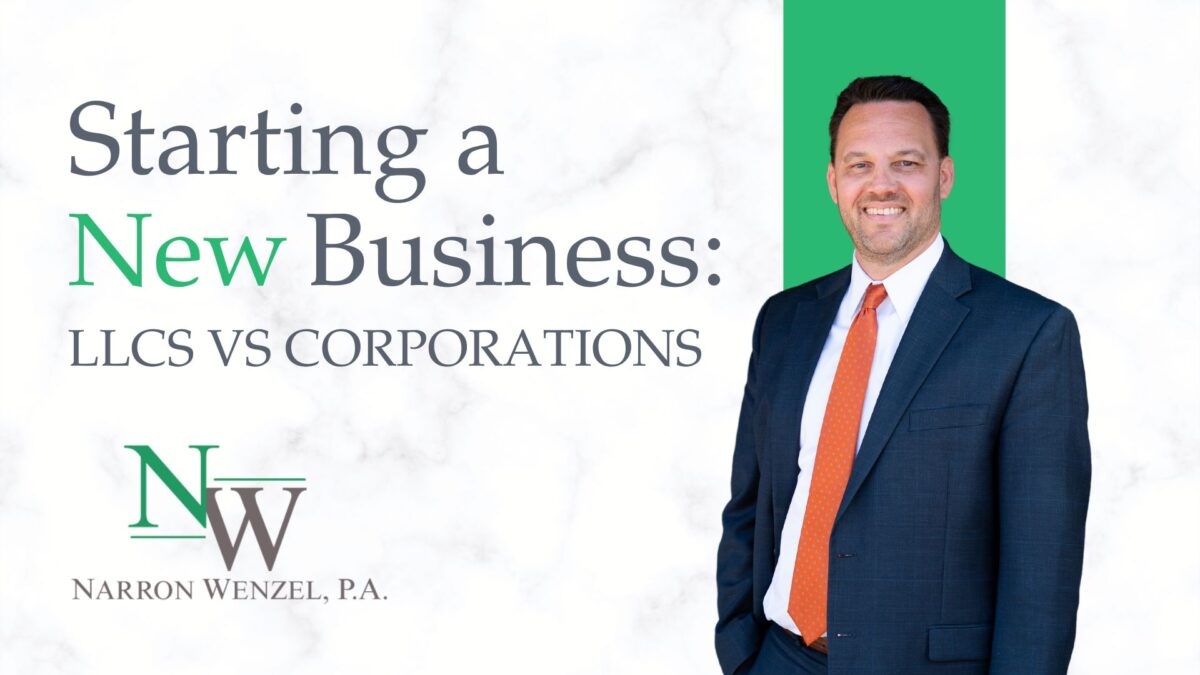
Starting a New Business: LLCs vs Corporations
The first question most people must decide when starting a new business is what type of entity they should form to operate the business. There are several different entity choices under state law, but by far the most common choices are limited liability companies (“LLCs”) and corporations. In this post we will attempt to highlight some of the key differences between the two with the hope of helping you make an informed decision in starting your new business.
1. Ownership, Management and Operations: Corporations are the traditional form of business entity that most people think about when they start a company. The corporation is owned by shareholders, who each own shares in the corporation. Those shares, depending on the structure, generally allow the shareholder the right to vote to elect directors of the company and other corporate matters. The directors, as members of the Board of Directors, then manage the corporation and its officers. Corporations are governed by Chapter 55 of the North Carolina General Statutes which provide myriad duties and rules on shareholders. These rules should be followed closely to maintain the liability protections afforded corporate status, as discussed below.
A newer statutory creation, relative to corporations, LLCs are owned by members, who generally own percentages of the new entity. LLCs can be either Manager Managed or Member Managed, a choice that will be made upon formation with the signing of an operating agreement. Managers may or may not be Members, and Members elect the Managers of the LLC, who run the day-to-day operations of the LLC. LLCs are governed by Chapter 57D of the North Carolina General Statutes and allow significant flexibility in operations by way of agreement between the members. There is no requirement for corporate minutes or meetings and the Operating Agreement between the parties will dictate almost all terms.
2. Income Tax Treatment: Depending on the type and number of shareholders, a corporation can be taxed as either a C Corporation or an S Corporation. C Corporations have two levels of taxation on corporate profits distributed to shareholders. The profits are taxed first at the corporate level (currently a 21% corporate tax rate), and once more in the form of tax on dividends paid to shareholders. S Corporations are a type of flow-through entity where all income of the corporation flows through and is reported directly by the shareholders, regardless of whether distributions of cash are actually made. This can be beneficial in escaping the first corporate level tax, however, an S Corporation shareholder is liable for the income tax on the corporation’s income regardless of whether cash is actually distributed from the company. To qualify as an S Corporation, the corporation’s shareholders are generally limited to individuals and certain types of trusts.
LLCs, from a tax standpoint, are extremely flexible. An LLC’s default tax classification by the IRS is to be taxed as a partnership if there are two or more owners. A partnership, much like an S Corporation, is a flow-through entity in which the tax of the partnership flows through to the partners and is reported on their individual returns. If there is only one owner, the LLC is disregarded for tax purposes and all income is reported on Schedule C of the individual’s Form 1040. Additionally, the IRS allows for the owners of an LLC to elect to be taxed as either a C Corporation or an S Corporation by making and filing the appropriate elections. Forming as an LLC can allow the Members the option to change the LLCs tax classification at a later date should it need to for planning purposes.
3. Liability Protection: There are two aspects of liability protection to consider here: shareholder liability protection from corporate acts and a shareholder’s creditor’s rights to seize assets. If the corporate formalities mentioned above are adhered to closely, a corporation’s liabilities will not otherwise be imposed upon its shareholders. If those formalities are not met, the corporate form may be ignored, and the corporate liabilities may be asserted against the shareholders individually by piercing the corporate veil. Alternatively, if a shareholder has his own creditor issues, the shares of stock of a corporation are considered personal property, and those shares are subject to a judgment creditor’s right to seize those shares to be sold to pay debts.
An LLC offers the same protections from company creditors as does a corporation. However, there are no corporate formalities to follow in order to garner this protection. The LLC, by statute, offers the limited liability protections, limiting member liability to the amount invested in the LLC. The highlight of the LLC entity choice is creditor protections provided to individual Members. Whereas corporate shares are subject to seizure by a creditor, a member’s LLC membership interest is not subject to seizure. Rather, the creditor is limited to a charging order against the interest wherein any company profits that are actually distributed to the member must first go to pay the creditor’s claim. This protection affords the member the ability to continue to own and operate the business without having a creditor sell the membership interests to pay the debts. It is important to note that courts have been willing to look through the charging order regime in cases of single member LLCs, so the ideal entity set-up would include two or more members to guarantee those protections.
LLCs offer great flexibility to a new business owner that is not otherwise available in corporate form. However, each new business has its own set of circumstances that may warrant the choice of a corporation over an LLC. We encourage you to speak to an attorney to discuss the formation of your new entity and the legal and tax ramifications of that decision.
